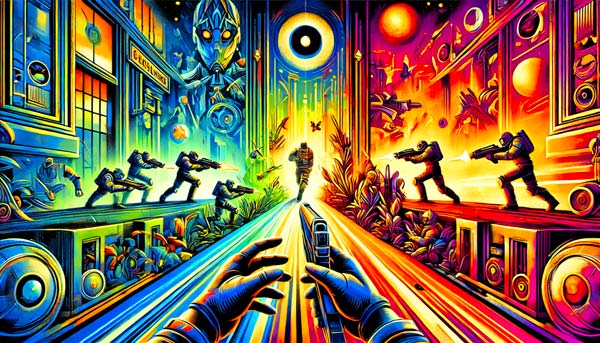
Picture wandering through a lush, vibrant forest, the trees swaying gently as you feel the crunch of leaves beneath your feet. Now, envision this scene not in a painting, but on your TV screen, controlled by your fingertips. This is the immersive world of video games, where art and technology intersect in ways that continue to spark debate. Are video games merely entertainment, or do they qualify as a legitimate form of art? This question has been at the forefront of discussions among gamers, critics, and artists alike.
The debate over video games as art is not a new one. It has been a topic of conversation for decades, gaining momentum as the medium has evolved. While some argue fervently that video games are a revolutionary new form of artistic expression, others remain skeptical, viewing them as simple diversions. Let’s explore the history, arguments on both sides, notable examples, and the future of video games as art, aiming to shed light on this multifaceted issue.
Historical Context
In the early days of video games, titles like Pong and Pac-Man captivated audiences with their simple yet addictive gameplay. These early games were rudimentary, both in graphics and narrative, focusing primarily on providing fun and challenging experiences. During this period, video games were often seen as children’s toys or novel forms of entertainment rather than serious artistic endeavors. The idea of video games as art was far from mainstream consideration.
As technology advanced, so did video games. The 1980s and 1990s saw the emergence of more complex games with richer stories and better graphics. Titles like Super Mario Bros., The Legend of Zelda, and Final Fantasy began to introduce deeper narratives and more intricate worlds. These developments started to change the perception of video games, suggesting that they could offer more than just amusement.
The rise of video games as a cultural phenomenon cannot be overstated. With the advent of home consoles and personal computers, gaming became a popular pastime for people of all ages. This widespread acceptance led to greater investment in the industry, resulting in technological advancements that allowed for even more sophisticated game design. As games began to feature more elaborate storytelling and visually stunning graphics, comparisons to other art forms, such as film, became inevitable.
However, the journey from simple entertainment to recognized art form is not unique to video games. Similar debates occurred with the introduction of film in the early 20th century. Initially dismissed as a passing fad, film eventually gained recognition as an art form capable of profound expression and storytelling. This historical parallel provides a useful framework for understanding the current debate over video games.
Defining Art: The Criteria
To understand whether video games can be considered art, it’s important to first define what art is. Traditional definitions of art encompass a wide range of forms, including painting, sculpture, literature, and music. Art is often characterized by its ability to convey emotions, tell stories, and provoke thought. It involves creativity and expression, aiming to connect with its audience on a deeper level.
When we look at video games through this lens, several key elements come into focus. Video games combine graphics, music, storytelling, and interactivity to create immersive experiences. These components can be compared to traditional art forms: graphics to visual art, music to composition, storytelling to literature, and interactivity to performance art. The synthesis of these elements in video games suggests that they have the potential to meet the criteria of art.
Artistic elements are evident in many video games. Consider the intricate world-building in games like The Elder Scrolls series or the emotional narratives in games like Life is Strange. These games demonstrate a high level of creativity and craftsmanship, often involving teams of artists, writers, and designers working together to create a cohesive artistic vision.
Moreover, video games often push artistic boundaries. Games like Journey, with its minimalist design and evocative score, challenge traditional notions of what a game can be. Similarly, games like Shadow of the Colossus use their gameplay mechanics to convey deep, existential themes. These examples show that video games can indeed fulfill the role of art by engaging players emotionally and intellectually.
Arguments in Favor of Video Games as Art
One of the strongest arguments in favor of video games as art is the level of artistic expression involved in game design. Game developers are, in many ways, artists. They create intricate worlds, compelling characters, and engaging stories. This creative process is similar to that of traditional artists, requiring imagination, skill, and a deep understanding of their medium.
Consider games like Journey, The Legend of Zelda: Breath of the Wild, and The Last of Us. These titles are often cited for their artistic merits. Journey’s visual style and music create an emotionally resonant experience, while Breath of the Wild’s open-world design allows for unparalleled exploration and discovery. The Last of Us, with its rich narrative and complex characters, rivals the storytelling found in the best films and novels.
Another compelling argument is the emotional and intellectual engagement that video games offer. Players often report profound emotional experiences while playing games. For instance, the sense of wonder and awe in Journey, the deep connection with characters in The Last of Us, or the sense of accomplishment in completing a challenging quest in Breath of the Wild. These emotional responses are similar to those elicited by traditional forms of art.
Interactivity is another unique aspect of video games that supports their classification as art. Unlike traditional art forms, which are often passive, video games require active participation from the audience. This interactivity adds a new dimension to the artistic experience, allowing players to engage with the art on a deeper level. Games like Minecraft, which allow players to create and explore their own worlds, demonstrate the creative potential of interactivity.
Arguments Against Video Games as Art
Despite these compelling arguments, there are significant criticisms that challenge the notion of video games as art. One common criticism is the perceived lack of depth and seriousness in many games. Critics argue that the majority of video games are designed primarily for entertainment, often focusing on action and spectacle rather than artistic expression. Games like Call of Duty or Fortnite, which emphasize fast-paced gameplay and competitive multiplayer, are often cited as examples.
Another argument against video games as art is their commercial nature. The video game industry is highly profit-driven, with many games designed to maximize sales and appeal to the broadest possible audience. This commercial pressure can sometimes result in games that prioritize profit over artistic integrity. However, this is not a challenge unique to video games; other art forms, like film and music, also navigate the tension between art and commerce.
The debate also touches on the technical skills involved in game development. Critics argue that programming and game mechanics are more technical than artistic. While game development does require a high level of technical expertise, this does not necessarily exclude it from being an art form. Many traditional art forms, such as filmmaking or architecture, also require technical skills and collaboration between different disciplines.
Lastly, some argue that the collaborative nature of game development dilutes individual artistic vision. Unlike a painting or a novel, which is often the work of a single artist, video games are typically created by large teams. However, collaboration is also a feature of many recognized art forms, such as theater or film. The collaborative process in game development can lead to rich, multifaceted works of art.
Notable Examples and Case Studies
Journey, released in 2012 by thatgamecompany, is often hailed as a masterpiece of interactive art. Its minimalist design, stunning visuals, and evocative music create an emotionally charged experience. The game follows a robed figure traveling through a vast desert towards a distant mountain. The simplicity of its mechanics, combined with its atmospheric presentation, allows players to project their own emotions and interpretations onto the journey. Critics and players alike have praised Journey for its artistic innovation and emotional impact.
The Legend of Zelda: Breath of the Wild, released in 2017 by Nintendo, is another game that exemplifies the artistic potential of video games. Its expansive open world, filled with breathtaking landscapes and intricate details, invites players to explore and discover at their own pace. The game’s design encourages creativity and experimentation, allowing players to interact with the environment in various ways. Breath of the Wild’s blend of gameplay, visual artistry, and immersive world-building has earned it widespread acclaim.
The Last of Us, developed by Naughty Dog and released in 2013, is often cited for its narrative and emotional depth. Set in a post-apocalyptic world, the game follows the journey of Joel and Ellie as they navigate a landscape filled with danger and loss. The game’s storytelling, character development, and moral complexity rival that of the best films and novels. The Last of Us has been praised for its ability to evoke deep emotional responses from players, demonstrating the power of video games as a storytelling medium.
These examples illustrate that video games can achieve a level of artistic expression comparable to traditional art forms. They show that video games have the potential to evoke emotions, tell compelling stories, and provide immersive experiences that resonate with players on a profound level.
The Future of Video Games as Art
As technology continues to advance, the artistic potential of video games is expanding. Virtual reality (VR) and augmented reality (AR) are pushing the boundaries of what is possible in game design. These technologies allow for even more immersive and interactive experiences, opening up new possibilities for artistic expression. Games like Beat Saber and Half-Life: Alyx showcase the potential of VR to create unique and engaging art forms.
Changing perceptions and growing acceptance are also shaping the future of video games as art. Increasingly, video games are being studied in academic settings and featured in art exhibitions. Institutions like the Museum of Modern Art in New York have begun to include video games in their collections, recognizing their artistic value. This growing recognition is helping to legitimize video games as a form of art.
Indie games play a crucial role in this evolving landscape. Independent developers, often free from the commercial pressures of larger studios, are pushing the boundaries of what video games can be. Games like Celeste, Undertale, and Hades have been celebrated for their innovation, creativity, and artistic merit. Indie games are often more experimental, allowing developers to explore new ideas and artistic expressions.
The future of video games as art is promising, with the potential for even greater innovation and recognition. As technology advances and perceptions continue to shift, video games are poised to further establish themselves as a legitimate and influential form of art.
Conclusion
The debate over whether video games are art is complex and multifaceted. By examining the historical context, defining art, and exploring arguments on both sides, we can gain a deeper understanding of this ongoing discussion. Notable examples like Journey, The Legend of Zelda: Breath of the Wild, and The Last of Us demonstrate that video games have the potential to achieve a level of artistic expression comparable to traditional art forms. As technology advances and perceptions shift, the future of video games as art looks increasingly promising.
Whether or not you consider video games to be art, there’s no denying their impact on our culture and their ability to provide profound and immersive experiences. The conversation about video games as art is far from over, and it will continue to evolve as the medium itself evolves. So, do you think video games are art?




